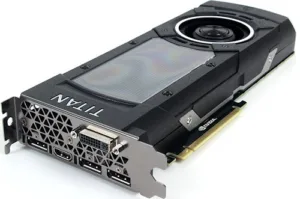We heard about Nvidia’s Titan X earlier this month (Nvidia Reaffirms Move to Gaming Products With Streaming Console), when it was previewed at GDC 2015. Now, the company has officially announced the card at its GPU Technology Conference.
UltraHD gaming will, of course, be supported by the new device. Virtual reality is also a focus. In terms of technologies, the Titan X supports multi-frame anti-aliasing and Nvidia’s Dynamic Super Resolution (downscaling UltraHD images to 1920 x 1080). Voxel Global Illumination accelerates dynamic lighting effects while Gamestream enables the PC games to be streamed to the Nvidia Shield.
Anti-screen tearing technology G-Sync is supported, as is a similar system called Adaptive VSync. GPU Boost 2.0 monitors and controls temperature, overclocking and overvoltage to maintain peak performance. The card will also support four-way SLI and multi-monitor use: up to four monitors can be driven by a single GPU, with 5760 x 1080 resolution across all displays.
Nvidia CEO Jen-Hsen Huang announced at GDC that the Titan X would have 128GB of VRAM – the same amount as last year’s Titan Z. At the GTC, it was revealed that the new card will cost one-third of the price of the Titan Z: $1,000.
The card is based on the Maxwell architecture, with ‘double’ the performance and power efficiency of the Titan Z; it has a 250W TDP, compared to 375W.
There are 3,072 CUDA cores and 7TFLOPs of peak single-precision performance (the Titan Z will remain available for users who require double-precision). 8 billion transistors and 336.5GB of memory bandwidth per second are featured. The card runs at 1GHz, with a 12GB frame buffer. 6- and 8-pin connectors are featured.

